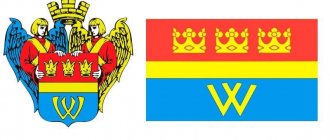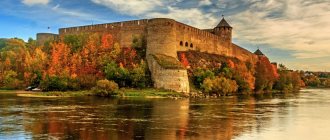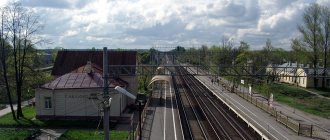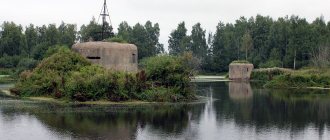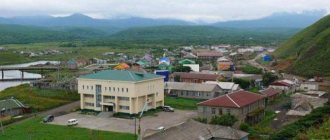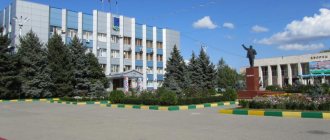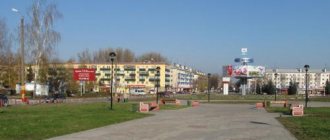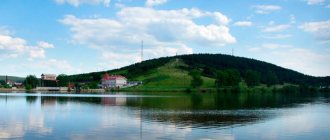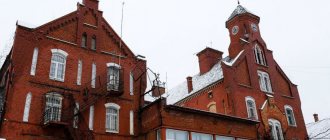City in Leningrad Oblast, Russia
| Tosno Tosno | |
| Town[1] | |
| Welcome sign at the northern entrance to Tosno | |
| Flag Coat of arms | |
| Location Tosno | |
| Tosno Location Tosno Show map of Russia Tosno Tosno (Leningrad region) Show map of Leningrad region | |
| Coordinates: 59°33′N 30°54'E / 59.550°N W. 30.900 ° E. / 59.550; 30.900Coordinates: 59°33′N 30°54'E / 59.550°N W. 30.900 ° E. / 59.550; 30.900 | |
| A country | Russia |
| Federal subject | Leningrad region[1] |
| Administrative region | Tosnensky district[1] |
| Municipal settlement | Municipal formation of the village of Tosnenskoye[1] |
| First mention | 1500[2] |
| City status from | February 1, 1963[3] |
| Height | 37 m (121 ft) |
| population (2010 Census)[4] | |
| • General | 39,101 |
| • Evaluate (2018)[5] | 37,509 (−4.1%) |
| Administrative status | |
| • Capital from | Tosnenskoye district[1], Municipal formation of Tosnenskoye village[1] |
| Municipal status | |
| • Municipal district | Tosnensky municipal district[6] |
| • Urban village | Tosnenskoye urban settlement[6] |
| • Capital from | Tosnenskoye municipal district[6], Tosnenskoye town[6] |
| Timezone | UTC + 3 (MSK [7]) |
| Postal code(s)[8] | 187000–187003, 187009, 187099 |
| OKTMO I WOULD | 41648101001 |
Tosno
(Russian: Tósno) is a town and administrative center of Tosnensky District in Leningrad Oblast, Russia, located on the Tosna River, 53 km (33 mi) southeast of central Saint Petersburg. Population: 39,101 (2010 Census);[4]38,683 (2002 Census);[9]32,459 (1989 Census).[10]
Story
The village of Tosno was first mentioned in Russian chronicles in 1500.[2] It was part of Vodskaya Pyatina, one of the five Pyatina
into which the Novgorod lands were divided.[11]
During the administrative reform carried out in 1708 by Peter the Great, Tosno was part of the Ingermanland province (from 1710 St. Petersburg province).[ citation needed
] Its development in the 18th-19th centuries was determined mainly by its geographical position on the road between the two capitals of Russia.
Since 1774 it has been a station on the sweet potato route. In 1849, the railway connecting Tosno with St. Petersburg and Chudovo opened.[11] In the 19th century, Tosno was part of the Tsarskoye Selo district (renamed in 1918 to Detskoselsky district)[ citation needed
];[12] In accordance with this, in 1913 the province was renamed Petrograd.[
citation needed
] and Leningradsky in 1924. ).[12]
On August 1, 1927, the counties were abolished and the Kolpino district, with its administrative center in the city of Kolpino, was founded.[13] The governorates were also abolished, and the district became part of the Leningrad Okrug of the Leningrad Region.[13] Tosno became part of the Kolpinsky district.[13] On August 19, 1930, the Kolpinsky district was abolished.[13] Tosno became the administrative center of the newly formed Tosnensky district.[3] On August 20, 1935, Tosno was granted an urban settlement status.[3] From August 28, 1941 to January 26, 1944 during World War II, Tosno was occupied by German troops and was largely destroyed, but rebuilt after the war.[14] On February 1, 1963, Tosno received city status.[3]
Beautiful Tosno caves
The man-made Sablinsky caves, located on the territory of the natural monument of the same name, arose in the era of Catherine the Great, when sandy quartzite was mined in these places in order to develop the glass industry. Sometimes Sablinsky caves are called catacombs. In addition to Levoberezhnaya, tourists are also attracted to other caves. There are about 14 of them here. Below are some of the most interesting ones.
Pearl Cave
- Coordinates: 59.668799, 30.799739.
The length of the cave system, known as Zhemchuzhnaya, is about 5,500 meters. Inside the cave there is a labyrinth with two entrances, the height of the labyrinth corridors is about 160 meters. This cave is intended for independent visiting, but tourists are warned that some passages may be blocked or flooded.
In one of the cave halls there is an object called the “grave of the white speleologist.” Here is a set of rules of conduct. Some cave passages are very narrow. The multi-colored soil and sand layers on the cave walls look very picturesque.
Pants Cave
- Coordinates: 59.667430, 30.801293.
The cave system adjacent to Zhemchuzhnaya has a total length of 1.7 km. The “ceilings” here are low, from 1 to 1.6 meters, so you will have to crouch down to move around the cave. Of greatest interest is the narrow manhole, which was dubbed the “Trans-pipe” or “Leningrad tram”.
Rope Cave
- Coordinates: 59.661662, 30.802308.
A passage leading to the 800-meter-long cave, located on the right bank of the Tosno River, is located almost at water level. The Rope Cave is easy to navigate but atmospheric.
Count's Grotto
- Coordinates: 59.666492, 30.802588.
A small but simple and spacious 400-meter cave is known as Beach, Count or Count's Grotto. The height of the “ceilings” here reaches 5 meters.
Economy
Industry
The plant owned by Gusenitsa in Tosno produces trucks for quarries.[15] There are also several businesses associated with the construction industry.
Transport
Tosno railway station
On the M10 Highway connecting Moscow to St. Petersburg and Moscow - st. The St. Petersburg railway runs around the city. The railway connecting Tosno with the village. Caps branches off to the east. The shortest route connects Tosno with the railway between Mga and Gatchina and is used for trains bypassing St. Petersburg from the south.
Roads connect Tosno with Shapki and Mga in the east and with Lisino-Korpus and Vyritsa in the West.
Canyon
Sablinsky caves are the main man-made tourist sites. They appeared at the end of the 19th - beginning of the 20th centuries. Quartz sand has been mined in this place for a long time. Tourists from all over the country come on excursions to the four main parts of the cave: Pants, Garbage, Rope, and Pearl.
The canyon near the river produces many minerals: Cambrian clay, marcasite with pyrite, considered gold for fools. Tolstoy even chose this place to indicate the Country of Fools, since there was quite a lot of pyrite at that time. But it is not completely known whether the writer lived here, since after the war there was practically no information left about him.
Recommendations
Notes
- ^ a b c d f g gram hour
Area Law No. 32-ounce - ^ a b Encyclopedia of Russian Cities
. Moscow: Great Russian Encyclopedia. 2003. p. 475. ISBN 5-7107-7399-9. - ^ a b c d
Tosnensky district (August 1930) (in Russian). System of classifiers of executive bodies of state power of St. Petersburg. Retrieved March 14, 2014. - ^ a b
Federal State Statistics Service of Russia (2011).
“All-Russian Population Census 2010. Volume 1" [All-Russian Population Census 2010, vol. 1]. All-Russian Population Census 2010 [All-Russian Population Census 2010]
(in Russian). Federal State Statistics Service. - "26. The size of the permanent population of the Russian Federation by municipalities as of January 1, 2022.” Federal State Statistics Service. Retrieved January 23, 2022.
- ^ a b c d f
Law No. 116-oz. - "On the calculation of time." Official Internet portal of legal information
(in Russian). June 3, 2011. Retrieved January 19, 2022. - Post office. Information and computing center of OASU RPO. ( Post office
).
Search for postal facilities ( Search for postal facilities
) (in Russian) - Federal State Statistics Service of Russia (May 21, 2004). “The population of Russia, the constituent entities of the Russian Federation as part of federal districts, urban settlements, urban settlements, settlements, settlements of 3 thousand or more people.” [Population of Russia, its federal districts, federal subjects, districts, urban settlements, rural settlements - administrative centers, rural settlements with a population of more than 3000 people] (XLS). All-Russian Population Census of 2002 [All-Russian Population Census of 2002]
(in Russian). - “All-Union Population Census of 1989. Current population of union and autonomous republics, autonomous regions and districts, territories, regions, urban settlements and villages. Production of Caterpillar mining dump trucks in Tosno: strategies and prospects” (in Russian). MAXI Excavator. Retrieved January 26, 2013.
- Monuments of history and culture of the peoples of the Russian Federation (in Russian). Ministry of Culture of Russia. Retrieved June 2, 2016.
- Tosnensky Museum of Local Lore (in Russian). Russian Network of Cultural Heritage. Retrieved January 23, 2013.
small waterfall
In Tosno there is a waterfall in Sablino, it is considered the largest in Europe. It is noted that the waterfall changes its pressure and can reach from 2 to 4 meters. Despite its size, the waterfall was called a mini-Niagara for its majestic appearance. When the time of flood comes, it is better not to get close to the waterfall.
You are allowed to visit this place on your own, without additional excursions. People take healing baths in this place, so everyone can experience the power of the Tosno waterfall for themselves. Residents of nearby villages also loved this place.
Geography, relief and climate
The area of the Tosnensky district is 3585 square kilometers. It borders with the Novgorod region, St. Petersburg, as well as with the Luga, Gatchina, Kirishi and Kirov districts of the Leningrad region.
The relief of the Tosnensky district is predominantly flat, although in some places there are hills and elevated terrain. Most of the territory (80%) is covered with forest, and there are swamps. There are practically no lakes, the largest is Pendikovskoye. Of the large rivers, only Tosna is worth mentioning. In general, the Tosnensky district is not rich in water resources.
The climate is temperate continental, characterized by cool summers and mild winters. The average annual precipitation is 700 millimeters. The weather in general is no different from the Leningrad region as a whole. Air masses from the Atlantic Ocean have a great influence, thanks to which winters are often very warm, especially in recent years, when weather anomalies are regularly observed.
Main streets of Tosno
The grid of streets with houses, judging by the map of Tosno, is strictly subordinate to the directions of railway tracks and roads. The largest of them are the following:
- st. Ani Alekseeva. Many social and public facilities are concentrated here, as well as a stadium and arena;
- st. Blinnikova . Educational institutions and large grocery stores are located here. And nearby is the Azure Pool;
- Barybina highway . One of the longest highways;
- st. Boyarova. A street where a huge number of cafes and restaurants, shops, and public places are located.
There are other major city arteries, but these are the ones considered historically important for the city.
Farm Maryino
The Maryino farm, which is located in the village of Primochnoe, has been operating as a mini-zoo for 8 years. A special feature is that the animals do not huddle in cages, they are kept in enclosures, which provides them with decent living conditions. There are also winter enclosures for each animal.
This is a kind of pet farm, where there are no exotic species of birds or horses. Decorative species of rabbits, ducks, and goats live beautifully here. Tourists are allowed to bring food for the animals and pet them; the animals are quite friendly and are accustomed to attention. The farm has its own fair offering natural dairy products from Yakut cows and goats; children are allowed to ride a horse, donkey or camel.
Sablinsky natural monument
On the territory of the Sablinsky natural monument there are two waterfalls, the canyons of the Tosny and Sablinka rivers. Hiking enthusiasts can easily pitch tents here, admire the beautiful nature, enjoy the fresh air and the murmur of water.
The Sablinsky Canyon is interesting for its geological structure; its walls consist of Ordovician and Cambrian sandstones and limestones of various shades.
And in the Tosnensky Canyon there are deposits of golden pyrite and marcasite. On the Tosna River there is an ancient waterfall, formed approximately 11 thousand years ago. People call it a smaller copy of Niagara Falls; it is considered the widest in Europe and in high water conditions it is up to thirty meters wide.
An equally beautiful waterfall with trees bending over the water is located on the Sablinka River, its height varies from two to five meters.
Church of the Kazan Icon of the Mother of God
The brick building of the church, the Church of the Kazan Icon of the Mother of God, was built in 1735 on the site of an old wooden church. The church was rebuilt more than once.
Services were also held there during the Nazi occupation, until 1943. In the 50s of the last century, the building was completely rebuilt; it housed a cultural center. Not a trace remained of the former church appearance. Only in 2009 the church building was returned to the believers.
Location: Lenin Avenue.
Trinity Church in Andrianovo
The temple was built in the village of Andrianovo in 1831, on the site of an old wooden church. The architecture of the building is made in a neo-Gothic style, unusual for the Orthodox Church. The temple was the tomb of the princely family of Golitsyn. Unfortunately, today the temple is abandoned. However, in its appearance one can still see lancet windows, spiers and turrets.
